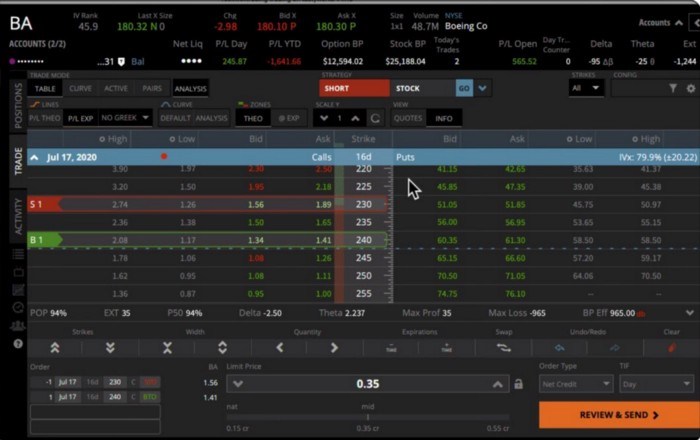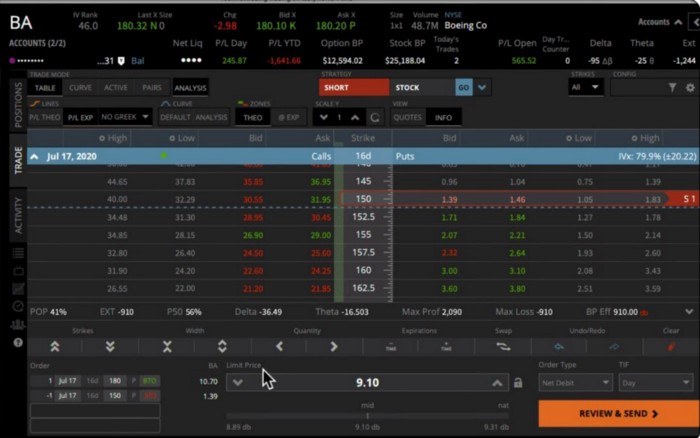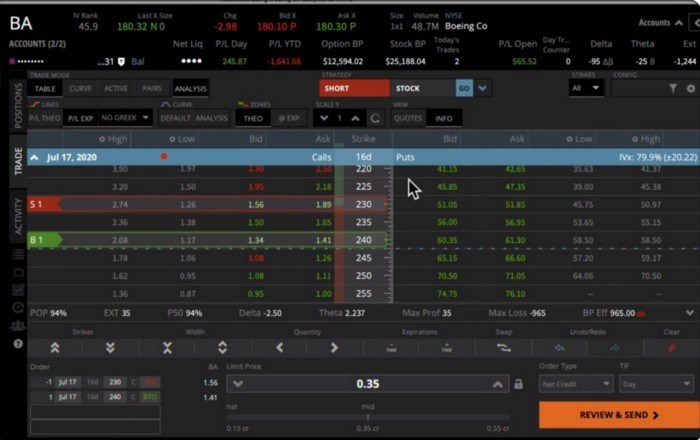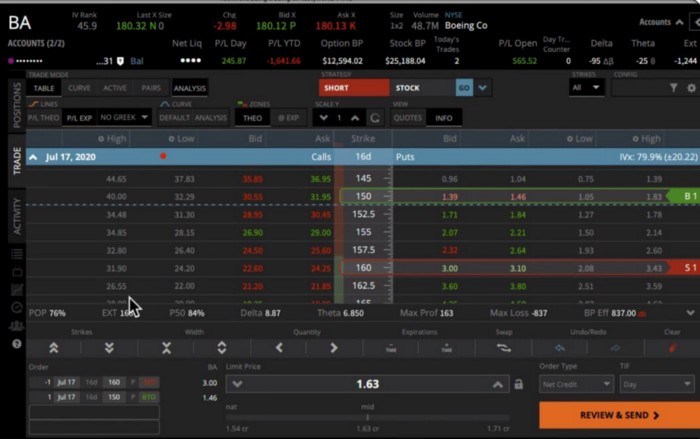You may have previously heard someone say, “ Vertical spreads are the same as getting weekly paychecks! “ Is that even true?
We’re going to go in-depth on each strategy to discuss each of the pros and cons. I’m also going to discuss how each strategy should be used in any given market condition. Since we’ve previously discussed credit spreads and debit spreads, you’re probably wondering… what’s the BEST vertical spread option strategy?
Let’s break down each of the vertical spread option strategies in detail and look at examples in Tasty Trade.
Call Debit Spread
What is a Call Debit Spread? A call debit spread is a position in which you buy a call option and sell a call option at different strike prices using the same expiration date.
When should this strategy be used? This strategy is used when you believe the stock is increasing in price, but not a dramatic movement.
What are the benefits of this strategy? Trading this position can potentially reduce the overall cost associated with taking on the trade. This type of strategy also reduces the break-even price of the trade.
When does this trade lose money? When the underlying stock moves sideways or downward.
What is the max risk for this trade? The max risk associated with this strategy is the cost of the premium paid to take on the trade.
What is the max reward for this trade? The max reward for this strategy is the difference between the strike price of the two calls, multiplied by 100. Minus the premium paid to take on the trade.
Call Debit Spread Example
-
Reduced Margin Requirement: $910
-
Max Risk Reduced: $910
-
Max Reward: $4090
Put Debit Spread
What is a Put Debit Spread? A put debit spread is a position in which you buy a put option and sell a put option at different strike prices with the same expiration date.
When should this strategy be used? This strategy is used when you believe the stock is decreasing in price.
What are the benefits of this strategy? Trading this position can potentially reduce the overall cost associated with taking on the trade. This type of strategy also lowers the break-even price of the trade.
When does this trade lose money? The underlying stock moves sideways or downward.
What is the max risk for this trade? The max risk associated with this strategy is the cost of the premium paid to take on the trade.
What is the max reward for this trade? The max reward for this strategy is the difference between the strike price of two calls, multiplied by 100. Minus the premium paid to take on the trade.
Put Debit Spread Example
-
Reduced Margin Requirement: $910
-
Max Risk Reduced: $910
-
Max Reward: $2090
Call Credit Spread
What is a Call Credit Spread? A call credit spread is a position in which you sell a call option and buy a call option as protection. These option contracts have different strike prices but have the same expiration date.
When should this strategy be used? This strategy is used when you believe the stock is decreasing in price or trading sideways.
What are the benefits of this strategy? Trading this position produces a credit from the premium received for selling the put option. Buying the additional call option provides protection, limiting the risk of the trade.
When does this trade lose money? This trade loses money when the underlying stock moves up quickly past your strike price.
What is the max risk for this trade? The max risk associated with this strategy is the difference between the strike prices, multiplied by 100.
What is the max reward for this trade? The max reward for this strategy is the premium received for selling the call option, minus the premium paid for protection.
Call Credit Spread Example
-
Margin Requirement: $965
-
Max Risk: $965
-
Max Reward $35
-
Premium Received: $35
Put Credit Spread
What is a Put Credit Spread? A put spread is a position in which you sell a put option and buy a put option as protection. These option contracts have different strike prices but have the same expiration date.
When should this strategy be used? This strategy is used when you believe the stock is increasing in price or trading sideways.
What are the benefits of this strategy? Trading this position produces a credit in the form of the premium received for selling the put option. Buying the additional put option provides protection, limiting the risk of the trade.
When does this trade lose money? The underlying stock moves downward sharply.
What is the max risk for this trade? The max risk associated with this strategy is the difference between strike prices, multiplied by 100.
What is the max reward for this trade? The max reward for this position is the premium received for selling the put option, minus the premium paid for protection.
Put Credit Spread Example
-
Margin Requirement: $837
-
Max Risk: $837
-
Premium Received: $163
-
Max Reward: $163
How Do I Choose The Best Vertical Spread Option Strategy?
I personally only select options that match my trading plan. You’ve probably heard me say it a million times if you’ve heard it once…
There are 3 things you need to know to be successful at trading.
1.) You need to know which options to trade
2.) You need to know when to enter
3.) You need to know when to exit
I use the PowerX Optimizer to help me execute these trades successfully.
Trading Futures, options on futures and retail off-exchange foreign currency transactions involves substantial risk of loss and is not suitable for all investors. You should carefully consider whether trading is suitable for you in light of your circumstances, knowledge, and financial resources. You may lose all or more of your initial investment. The lower the day trade margin, the higher the leverage and riskier the trade. Leverage can work for you as well as against you; it magnifies gains as well as losses. Past performance is not necessarily indicative of future results.
Editors’ Picks
EUR/USD stays in positive territory above 1.0850 after US data

EUR/USD clings to modest daily gains above 1.0850 in the second half of the day on Friday. The improving risk mood makes it difficult for the US Dollar to hold its ground after PCE inflation data, helping the pair edge higher ahead of the weekend.
GBP/USD stabilizes above 1.2850 as risk mood improves

GBP/USD maintains recovery momentum and fluctuates above 1.2850 in the American session on Friday. The positive shift seen in risk mood doesn't allow the US Dollar to preserve its strength and supports the pair.
Gold rebounds above $2,380 as US yields stretch lower

Following a quiet European session, Gold gathers bullish momentum and trades decisively higher on the day above $2,380. The benchmark 10-year US Treasury bond yield loses more than 1% on the day after US PCE inflation data, fuelling XAU/USD's upside.
Avalanche price sets for a rally following retest of key support level

Avalanche (AVAX) price bounced off the $26.34 support level to trade at $27.95 as of Friday. Growing on-chain development activity indicates a potential bullish move in the coming days.
The election, Trump's Dollar policy, and the future of the Yen

After an assassination attempt on former President Donald Trump and drop out of President Biden, Kamala Harris has been endorsed as the Democratic candidate to compete against Trump in the upcoming November US presidential election.
RECOMMENDED LESSONS
Making money in forex is easy if you know how the bankers trade!
Discover how to make money in forex is easy if you know how the bankers trade!
5 Forex News Events You Need To Know
In the fast moving world of currency markets, it is extremely important for new traders to know the list of important forex news...
Top 10 Chart Patterns Every Trader Should Know
Chart patterns are one of the most effective trading tools for a trader. They are pure price-action, and form on the basis of underlying buying and...
7 Ways to Avoid Forex Scams
The forex industry is recently seeing more and more scams. Here are 7 ways to avoid losing your money in such scams: Forex scams are becoming frequent. Michael Greenberg reports on luxurious expenses, including a submarine bought from the money taken from forex traders. Here’s another report of a forex fraud. So, how can we avoid falling in such forex scams?
What Are the 10 Fatal Mistakes Traders Make
Trading is exciting. Trading is hard. Trading is extremely hard. Some say that it takes more than 10,000 hours to master. Others believe that trading is the way to quick riches. They might be both wrong. What is important to know that no matter how experienced you are, mistakes will be part of the trading process.




